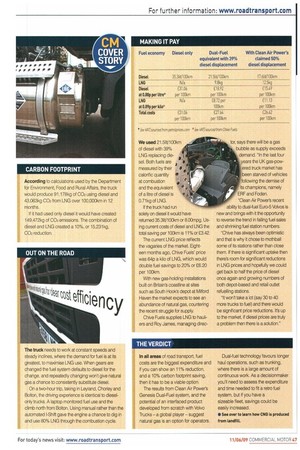CARBON FOOTPRINT
Page 47

If you've noticed an error in this article please click here to report it so we can fix it.
According to calculations used by the Department for Environment, Food and Rural Affairs, the truck would produce 91,178kg of CO2 using diesel and 43,063kg CO2 from LNG over 100,000km in 12
rrionths. If it had used only diesel it would have created 14 9,472kg of CO2 emissions. The combination of d esel and LNG created a 10%, or 15,231kg, CO2 reduction,
"Ole truck needs to work at constant speeds and s eady inclines, where the demand for fuel is at its greatest, to maximise LNG use, When gears are changed the fuel system defaults to diesel for the change, and repeatedly changing won't give natural gas a chance to consistently substitute diesel.
On a two-hour trip, taking in Leyland, Chorley and Bolton, the driving experience is identical to dieselonly trucks. A laptop monitored fuel use and the climb north from Bolton. Using manual rather than the automated I-Shift gave the engine a chance to dig in and use 80% LNG through the combustion cycle.
















































































































































